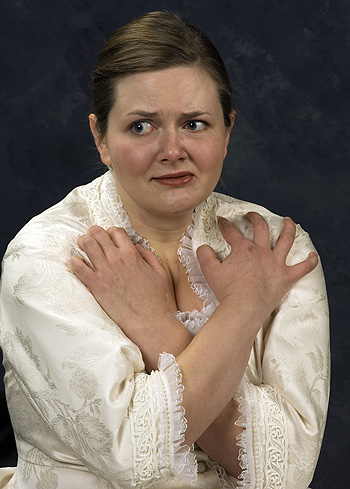Lizzie Borden took an ax
And gave her mother 40 whacks
When she saw what she had done
She gave her father 41
So goes the well-known nursery rhyme, though the victims were actually Borden’s father and stepmother. And more than 100 years after that infamous double murder, Borden — who was acquitted of the crime — remains the chief suspect.
This month, the Washington University Opera, led by director Jolly Stewart, instructor in voice in the Department of Music in Arts & Sciences, will explore the characters and conflicts that may (or may not) have caused Borden to snap with a new production of “Lizzie Borden,” Jack Beeson’s acclaimed three-act opera.

Performances, sponsored by the music department, begin at 8 p.m. Friday and Saturday, Feb. 22 and 23, in Edison Theatre.
Set in 1892 in Borden’s home of Fall River, Mass., “Lizzie Borden” combines fact, legend and a touch of Freudian analysis to create one plausible explanation for the tragedy. The story centers on the relationship between Lizzie and her younger sister, Margret, with their domineering father and stepmother, Andrew and Abigail.
“Andrew is the richest man in town and very, very strict,” Stewart said. “Abigail is the quintessential wicked stepmother, always smiling but also taking every opportunity to malign the girls and treat them like slaves. Lizzie and Margret are almost prisoners in their own home.”
Andrew is not only strict, but he’s also abusive. “Andrew abuses everybody verbally,” Stewart said, “but we feel that Lizzie has been sexually abused as well, though she’s largely been able to protect Margret.”
Events come to a head when a sea captain, Jason MacFarlane, asks Andrew for permission to marry Margret. Andrew refuses, offering Lizzie instead. Jason and Margret make secret plans to elope, but Lizzie — unhinged by abuse and fury, sensing the possibility of escape — begins to fantasize that Jason will return for her.
“One of the most interesting things about staging opera is the need to get inside people’s heads, to understand why they do what they do,” Stewart said. “In that sense, ‘Lizzie Borden’ represents the supreme challenge.”
Originally commissioned by the Ford Foundation, “Lizzie Borden” premiered March 25, 1965, at the New York City Opera. Beeson’s music — partially inspired by the nursery rhyme — captures Lizzie’s mounting anxiety through its striking use of dissonance and atonality, though the mood is leavened by more lyrical moments and by darting allusions to period hymns and parlor songs. The English libretto is by Kenward Elmsie, based on a scenario by Richard Plant.
The cast of six is led by WUSTL alumni Debra Hillabrand and Nathan Ruggles — both teachers of applied music in voice — as Lizzie and Andrew. Graduate students Courtney Dey and Alan Naylor play Margret and Jason. Rounding out the cast are junior Alison Moritz as Abigail and graduate student Joshua Stanton as Reverend Harrington, who accompanies MacFarlane to the Borden home.
John Stewart, director of vocal activities in the Department of Music in Arts & Sciences, conducts the performance, which will feature the St. Louis Symphony Youth Orchestra as well as the eight-member Kirkwood Children’s Chorus. Sets and lighting are by Patrick Huber, with costumes by Teresa Dogge.
Tickets are $18 for the public; $12 for seniors, faculty and staff; and $7 for students. For more information, call 935-6543 or visit edisontheatre.wustl.edu.